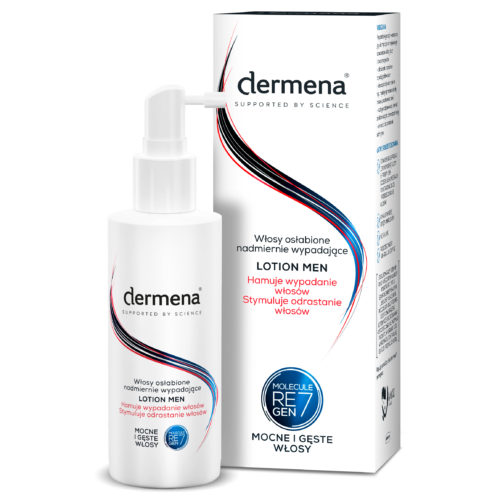Excessive hair loss in men

Excessive hair loss is a problem affecting both men and women. There are many various reasons for this (read: loss of hair). In case of men the most common cause of hair loss is androgenic alopecia, also called male pattern baldness. It concerns an average of every third man in the age between 25 and 40 and approximately 60% of men in the age of 50. It is genetically determined (often runs in families) and developing gradually. Usually it begins as a fronto-temporal hair loss and leads to receding hairline in frontal corners. Frequently, at the same time hair thins on the crown of the head. Hairless areas become more pronounced until they eventually meet. Hair remains only in the back of the head, the occipital part of the head.
Male pattern baldness is associated mainly with two factors:
- progressive miniaturization of the hair follicles,
- presence of androgens (male hormones).
In androgenic alopecia growth phase of a hair (anagen phase) is shortened, which leads to shortening and weakening hairs in subsequent cycles. At the same time, the falling out phase (telogen phase) and the period between telogen phase and the beginning of the next cycle are prolonged. This mechanism results from complex biochemical processes in hair follicles induced by dihydrotestosterone (DHT). DHT is a testosterone metabolite (male androgen hormone), produced by testosterone 5-alpha-reductase. The presence of DHT causes progressive miniaturization and reduced blood supply of hair follicles. This is due to changes of the structure of blood vessels of the scalp. Insufficient subepidermal circulation causes inadequate supply of nutrition to the hair follicle. Hair is getting thinner and less stained. Follicle size decreases with each cycle. Over time, hair growth is almost completely stopped. The action of androgens on hair follicle also increases the activity of sebaceous glands, resulting in excessive production of sebum and increases hair loss.
How to deal with male pattern hair loss?
Progression of male pattern hair loss is easiest to stop at early stages when follicular miniaturization is not complete.
The problem should be addressed comprehensively by:
- blocking conversion of testosterone to dihydrotestosterone (DHT),
- strengthening hair follicle by improving its blood supply and nutrition,
- reducing production of sebum.
Innovative comprehensive line of hair care products for male pattern hair loss, of a clinically proven effectiveness, is dermena® men.
Recommended products
dermena® MEN AMPOULE TREATMENT
- reduces hair loss
- stimulates hair growth
dermena® MEN LOTION
- reduces hair loss
- stimulates hair growth
dermena® MEN SHAMPOO
- reduces hair loss
- stimulates hair growth






